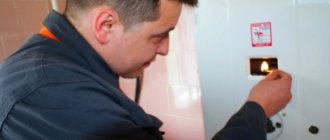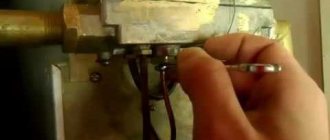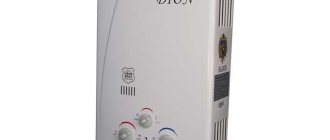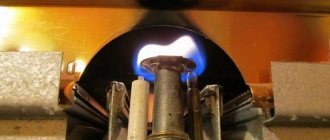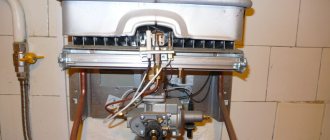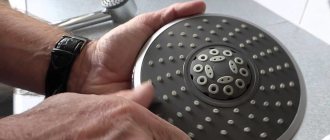A gas water heater is a popular household appliance. It is distinguished by its simplicity of design, reliability and ease of use. With proper care and timely replacement of consumables, such a unit can last a long time. However, like any mechanism, the water heater is subject to some breakdowns. Poor quality fuel, impurities in water, improper operation - all this leaves its mark, leading to malfunctions. If you notice that the geyser does not heat the water well or does not heat it at all, this is a clear indicator of serious problems inside the device.
The principle of operation of the speakers
Why doesn't the gas water heater heat the water? To answer this question, you need to understand the internal structure of the unit. The complexity of repair will depend on the design features of a particular model.
The operation of a gas water heater allows you to provide an apartment or small house with hot water. To directly heat the liquid, the device is equipped with a special part - a heat exchanger. In it, the water flow is distributed through thin channels that pass above the gas burner.
This method allows you to achieve rapid heating right during use, eliminating the need to collect liquid in an additional tank.
Other parts and sensors serve to control heating, protect the device, supply and ignite fuel. Based on the type of ignition system, water heaters are divided into three types.
- Piezo ignition is a system that allows you to do without an igniter.
- A device with an igniter - made in the form of a constantly burning wick. It is set on fire manually or using a toggle switch. Not the most practical device, widely used in previous generation speakers.
- Electric ignition system. It operates on the same principle as a car ignition.
The design of the device includes a water unit (“frog”), which includes a membrane and a gas valve connected by a rod. The gas supply valve can only open if there is good water pressure on the membrane. To put it simply, without a water flow it is impossible to supply fuel to the burner. Among other things, this system saves gas.
Gas water heater unit
Causes of problems
Is the heater not heating well, is cold water flowing from the tap? What could have happened:
- A thick layer of deposits on the outer walls of the heat exchanger (radiator). Soot and carbon deposits accumulate during operation: the thicker the mud layer, the more difficult it is to warm up the flow. This leads to the fact that Neva, Ariston and other brands of equipment do not heat the contents.
- Weak flame in the burner. This means that the membrane is faulty or worn out, and therefore does not create sufficient pressure on the gas valve.
- Radiator overheating. Impurities from the water supply settle on the walls and parts of equipment in the form of scale. It is difficult for the radiator to release heat to the environment, which leads to overheating.
- Insufficient pressure in the gas pipeline. You need to wait for restoration or contact the gas service.
- Late maintenance of equipment. Periodically, parts need to be cleaned and their functionality checked.
Let's take a closer look at all the causes of the malfunction and ways to eliminate them.
Major breakdowns
Having understood the structure, you can consider the typical problems that arise in such devices.
Blockage in the chimney
One of the most common reasons why water does not heat up can be a blocked ventilation well. A chimney clogged with debris is not able to create sufficient draft for combustion, so the protection system built into the device cuts off the fuel supply.
By cleaning the chimney from soot and foreign objects, you will eliminate the problem. You can check the system's functionality using a lit candle. Bring it to the well and follow the flame. If it deviates significantly, it means the traction is in order.
Faulty ignition system
The second most popular problem with water heaters is discharged batteries. This problem only affects systems with automatic ignition. Despite loud claims from manufacturers that their batteries last up to a year, they should be changed more often. In addition to simple discharge, the element may oxidize or simply be defective. Make it a rule to periodically check its condition.
To fix the problem you need to:
- check the functionality of the ignition activation keys;
- change batteries.
This is the simplest procedure that you can do yourself.
Weak water pressure
Often a geyser does not heat water well due to false activation of the protective system. Due to the weak liquid pressure on the membrane, the system does not turn on the gas supply valve. It’s easy to identify the problem: open the faucet and watch the flow of water. If it is weak, then there is a problem somewhere in the plumbing.
To fix the problem you will need:
- contact the utility service and clarify the reason for the low pressure;
- clean the filter system from contaminants or replace it with a new one;
- leave an application for pipe cleaning at the utility service;
- thoroughly clean the gas water heater from soot and soot;
- check the performance of the membrane and replace it with a new one if necessary;
Broken water supply system
A fairly rare problem that occurs when the equipment is configured incorrectly. If a gas water heater lights up but goes out after some time, the balance in the cold and hot liquid supply system is most likely upset. Experts say the following about this: you should not mix cold and hot water when using the column. This causes the burner flame to go out and is also contrary to the rules for working with the device. The breakdown can be corrected by reducing the pressure of the cold water flow.
Worn seal diaphragm
The next cause of failure may be a worn-out membrane in the check valve. Over time, intensive work deforms the part under constant loads. This leads to a loss of sensitivity at the burner ignition sensor, the gas valve does not open, and the column goes out. There is no way to prevent the situation; even the most reliable membranes lose their elasticity over time. Experts recommend replacing parts every five to seven years.
Detecting wear is quite simple - turn on the maximum water pressure. If the burner goes out, it means the problem is with the old membrane.
Attenuation during operation
If a fire lights up in the gas water heater and then goes out during operation, then the bimetallic sensor has failed. Its main task is to measure temperature and protect the device from excessive heating. Such a breakdown can manifest itself in different ways.
- The column turns on and works for some time without incident, then the burner goes out for no reason and the work stops. Attempts to ignite it again do not bring results. After 10 minutes the device can function again, but soon the gas will stop flowing again. The explanation for this lies in the excessive sensitivity of the sensor.
- Shutdowns and ignitions are chaotic in nature, and it is impossible to predict periods of stable operation. This time the problem occurs due to damaged wires of the device. Broken conductor insulation causes short circuits on the housing and tripping of the fuse.
This damage cannot be fixed at home. You need to contact service or directly the manufacturer.
Bimetallic sensor
This problem is “seasonal” in nature. Summer stuffiness or enclosed spaces can cause the device to overheat, which is not a breakdown in itself. Try moving the device to a ventilated area or contact a qualified technician.
Scale
A common reason why the column heats the water poorly may be excessive accumulation of scale on the heating element. With this problem, gas is steadily supplied to the burner, water circulates through it, but under such conditions it will not heat up to the required temperature.
Scale is formed as a result of contact of the device with bad water or idle burning of the igniter . Working after the main system is turned off, the heat exchanger evaporates the remaining water, thereby increasing the scale layer. Unwashed by influxes of fresh water, it manages to settle on the walls and become firmly entrenched. Over time, the heating element will stop heating and the column will stop working. The problem can be resolved by washing the heat exchanger in a special solution.
To avoid active scale formation, experts recommend installing a water filter.
Failure Prevention Measures
To reduce the likelihood of geyser malfunctions and safely enjoy hot water, it is necessary to carry out periodic maintenance. You can do the work yourself or use professional services.
Prevention involves disassembling and thoroughly cleaning the gas water heater. We have provided a detailed description of the manual service process in this material.
Periodic maintenance and cleaning of the chimney will extend the life of the gas water heater.
When carrying out maintenance work, do not forget about the chimney. When the channel for discharging combustion products becomes clogged with soot and foreign objects, the protection is triggered and the water heater is turned off.
Descaling the system
The water in Russian pipes has never been of good quality, therefore, during the operation of gas equipment, various salts and metals accumulate on the internal sections of the heat exchanger. In this case, the diameter of the outlets gradually narrows, and the scale layer reduces the thermal output of the entire system.
It turns out that with an acceptable water pressure, the pipes do not heat up sufficiently, and we get a significant decrease in efficiency. But this problem can be dealt with on your own. To clean the radiator from scale, simply rinse it. Depending on the degree of contamination, citric acid is used, and in difficult cases, specialized detergents are used.
Dismantling the geyser heat exchanger
To fully clean the system, it is necessary to remove the radiator from the gas water heater. Washing some individual parts is less effective, but if it is impossible to dismantle the element in principle, then you have to be content with little.
Before dismantling, it is necessary to turn off the column and turn off the gas and water supply taps. You also need to drain all liquid from the system. We release the panel behind which the radiator is located by unscrewing the fasteners and remove it. Carefully remove the heat exchanger, trying not to tilt it, because there is probably water left there.
Cleaning the heat exchanger from scale
The cleaning procedure itself is extremely simple: pour citric acid or a specialized product into the radiator and leave it for a couple of hours in some warm place. During this time, the composition will react with the scale and discharge it. Next, we rinse the heat exchanger with running water and install it in place in the reverse order of disassembly. If necessary, repeat the cleaning procedure.
What else can you do?
- To increase the temperature of the water flowing from the tap, you can do the following: turn the regulator all the way to the right, then open the water tap only halfway. Since the movement of water will slow down, it will warm up better.
- It would be a good idea to check the pressure in the gas pipes or in the cylinder. But you should not do this yourself - it is better to seek help from professionals.
- The water can remain cool if the faucet adds cold water to already heated water. Compare (by touch) the temperature of the water from the tap with the temperature of the outlet hose. If the water is colder, then the problem is in the faucet.
- If the temperature of the tap water constantly “jumps” and the gas water heater itself periodically turns off, the mixer or filter may be clogged. All these elements, as well as the shower head, should be checked from time to time for the presence of lime and rust deposits.
Fixing a leak in a gas water heater
This problem is relevant both for new equipment and for old gas boilers that have been operating for several years. The column can leak for a number of different reasons, but the main ones are the following:
- incorrect connection of water hoses;
- absence or wear of gaskets at joints;
- A fistula has formed in the radiator tube.
There are no problems with the first two cases: we go through and reconnect the hoses, not forgetting to lay the seals.
Experts recommend using silicone gaskets, especially for gas equipment. They provide decent tightness and last much longer than ordinary rubber or tow.
As for the fistula, you can try to solder it, but this is only a temporary solution. If the material begins to deteriorate and crack in one place, it means that soon the entire radiator will be covered in such fistulas. Therefore, the only correct option is to completely replace the heat exchanger.
Sealed geyser
How to clean the heat exchanger?
Sometimes it happens that the geyser does not heat well and generally stops glowing brightly. The reason often lies in the accumulation of excess dirt and soot on the internal walls of the burner.
To clean the column from excess dirt inside on your own, it is recommended to use lemon acid or household chemicals purchased at a hardware store. You can also attach a pump to the gas water heater to circulate water so that it actively moves through the heat exchanger manifolds. If a pump is not used to circulate water in everyday life, then you can simply pour citric acid or descaling agent into the pipes, wait a while and see the “bubbly” cleaning process. The mixture of water and scale in the form of bubbles should be carefully drained after the bubble reaction has formed. As soon as the heat exchanger is installed back, open the tap so that the water pressure washes away any remaining soot contamination.
Weak water heating
If, after eliminating the leak and cleaning the radiator, the water in the column still does not heat up to the proper level, then you should pay attention to other indirect reasons:
- insufficient gas pressure;
- faulty mixer;
- filter elements.
If gas arrives at the inlet from a pipeline or cylinder with insufficient pressure, the water simply does not physically have time to heat up. The solution to this problem is best left to the shoulders of gas service specialists.
It is easy to determine whether a mixer is faulty. All you have to do is put your hand on the hot water hose that runs under the sink. If it is cold, then the problem is with the gas boiler, and if not, then we adjust the mixer or change it.
One of the most common reasons for warm water instead of hot water is clogged filters. It is worth checking everything that has a grate or any independent cleaning modules along the way from the gas boiler to the mixer, and, if necessary, remove obstacles by thoroughly washing the elements.
Here is a short list of reasons why a regular gas water heater does not heat water. Some of them are easy to fix on your own, while others require professional intervention. Remember to take precautions when working with gas equipment and follow all instructions from professional mechanics. Among other things, timely replacement of wear parts will help avoid most breakdowns.
First aid
Before looking for a breakdown and calling a repairman, check that all conditions for normal operation of the column are met.
What to look for:
- If the water is not hot enough, check the temperature regulator and, if necessary, turn it to the desired value;
- If the device is working at maximum, the pressure is very good, but you need to make the water hotter, open the tap halfway;
- Check whether the gas tap is fully open, especially if you recently turned off the gas due to repairs or departure;
- If the dispenser operates on liquid gas, call a technician to inspect the cylinder and check its serviceability;
- Check to see if the cold water is turned on anywhere;
- Compare the temperature of the hose at the dispenser and the mixer. If it is different, the tap needs to be cleaned;
- Check if the filters are clogged.
If all of the above is working properly, but the water heating system still does not work well, you need to look for a breakdown in the device itself.
Checking the functionality of electrical elements
First, you should check the functionality of the hot water valve, and then see if the boiler on indicator light works.
If the light does not light and the water heater has stopped heating water, then the sequence of actions is as follows:
- The boiler is de-energized, emptied of water, and the housing cover is removed.
- At the ends of the thermostat you need to check the presence of incoming current. For this, it is advisable to use a special tester, and not an indicator, to prevent a break in the supply “zero”;
- If voltage is supplied, then you need to press the thermal protection button. Did it ensure inclusion? Now preventive cleaning of the heating element from scale will be required - it has overheated.
- The thermal protection could also work due to the fact that hot water does not flow out of the tank due to a broken safety valve. Please note that the valve can only be replaced with a standard one - it is not recommended to install a regular check valve here.
- You need to remove the thermostat and ring it. If it doesn't turn on, it needs replacement. Repairing a thermostat is problematic - in most cases there are no mechanical elements.
The water heater does not heat water due to lack of maintenance
No matter what kind of gas water heater you use, instantaneous or storage, regular maintenance is a mandatory procedure, which increases the efficiency of water heating and extends the service life. Neglecting this service will significantly reduce heating and the heater will stop heating water.
Literally every geyser has quite specific requirements for annual maintenance, so we do not recommend trying to clean anything yourself. You will get the desired result for only 2-3 months, after which the gas water heater will still stop heating.
If the gas water heater does not heat the water and the gas burns yellow, call our technician to your home. The specialist will conduct a comprehensive diagnostics and external inspection of the column to identify potential causes of malfunctions.
The geyser cleaning service also includes cleaning the filter elements of your plumbing, which in due course in the future can prevent premature failure of the geyser.
Remember that regular maintenance of a geyser can not only increase its heating efficiency, but also extend its trouble-free service life to ten years.
conclusions
If it happens that the gas water heater malfunctions and begins to heat the incoming water poorly, you should pay attention to its internal walls - perhaps contaminants in the form of dirt and scale have accumulated there. Such deposits can be easily removed yourself and your equipment will definitely return to its original condition.
Sources
- https://seositi.ru/otoplenie/kotly/gazovaya-kolonka-ploxo-greet-vodu.html
- https://tehnika.expert/klimaticheskaya/gazovaya-kolonka/pochemu-ne-greet-vodu.html
- https://sovet-ingenera.com/otoplenie/vodonagrevatel/pochemu-gazovaya-kolonka-ne-greet-vodu.html
- https://tehnofaq.ru/pochemu-voda-v-gazovoj-kolonke-ne-nagrevaetsya/
- https://oteple.com/prichiny-pochemu-gazovaya-kolonka-ne-greet-vodu/
- https://cosmo-frost.ru/gazovye-kolonki-i-kotly/neispravnosti-gazovye-kolonki-i-kotly/pochemu-gazovaya-kolonka-ploxo-greet-sovsem-ne-greet-vodu/
- https://www.o-vannoy.ru/gazovye-kolonki/ne-greet-vodu/
- https://eurosantehnik.ru/ploxo-greet-gazovaya-kolonka.html
The plug gets hot when the water heater is running
Heating of the fork (slight) is allowed during operation. But if it gets too hot, you need to:
- Visually check the condition of the tees and extension cords to which the device is connected. Try to choose an extension cord with a large cross-section of wire for fire safety purposes .
- Check the condition of the outlet to ensure that the water heater plug fits tightly into the sockets. In some cases, when a plug or socket is loose, the adjacent part of the wire may become hot.
An incorrectly selected extension cord can cause a fire in a house or apartment, since water heaters are powerful and energy-intensive devices (1.2-2.6 kW).
